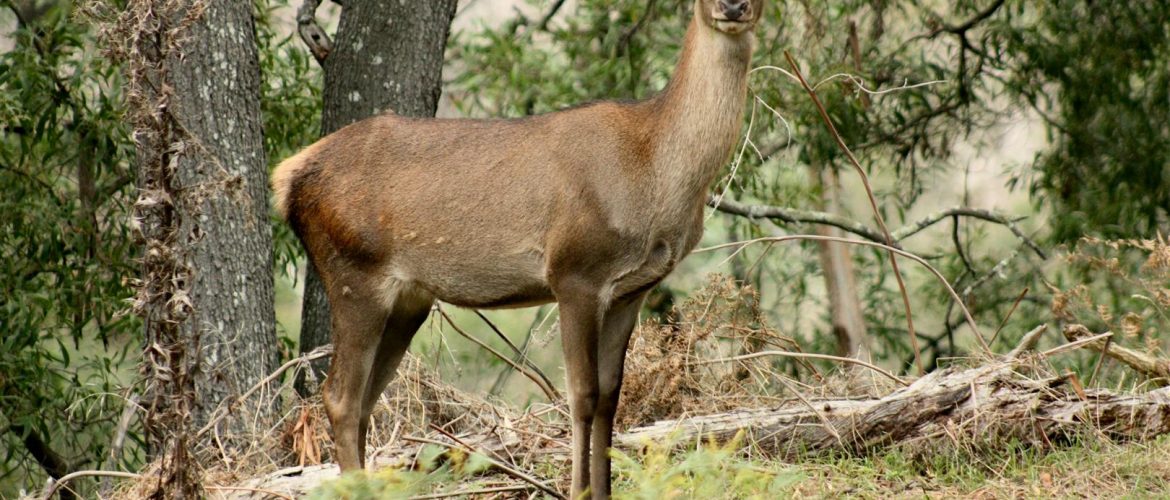$0.00
No products in the cart.

Red Deer (Cervus Elaphus)
“The deer that does look back!”
Although the Red Deer were originally released into Australia in a few selected different states in the late 1800’s such as Victoria, South Australia and Queensland, in recent years with escapes from deer farms and illegal releases there is now large and small herds across our wonderful country. To identify every Red deer herd in Australia would be impossible as every deer inclined person would be able to tell you where they have encounter reds.

I have studied Red deer in the mountain ranges within Western Victoria and also on the flat country of the South East district of South Australia noticing how the same species can acclimatise itself to its own circumstance. Within the mountain area’s that they frequent they are a browser with grazing being secondary yet on the flat country they are a grazing deer with browsing becoming secondary. Antler growth has a lot although not everything to do with the feed the deer consumes, having access to high protein crops such as lupins or Lucerne hay can benefit an animal that has its bloodline potential to bring out the best in the animal. Anyone involved with the deer farming industry will agree that a successful farmer will not spend thousands of dollars on animal food to attempt to make a feral deer into a “Master of the Glen” yet if he acquired a proven bloodline stag and fed it average to great food it will give him or her a herd to be proud of.
What I am saying is if you have a red deer herd in your area it is not necessary that if you let them go and let them grow that you will finish up with a trophy animal with a Douglas score of 300+. There are now red deer herds living in different pockets that should be controlled for meat production and others that have the trophy potential to produce the new Australian record. If you personally know the animals living in the area by studying their antler characteristics and are aware of the feed that is available to these animals you should be able to work out if this herd should be managed for the table or trophy.

To be successful in obtaining deer for whatever reason be it for a trophy set of antlers or venison for the table you need to understand as many things about the particular animal as possible and that also includes knowing the different habits between the males and females.
Hunting these beautiful animals starts early in the year or even late the year before if you are lucky enough to have time available so you get to thoroughly understand this animal especially if it’s your first year on the reds, as each of our deer species have different particular habits that if recognized will mean the difference between taking an animal or not during the year or season. During this time while stags are in velvet or growing their antlers they are much quieter, come out into more accessible areas and are easier to study and photograph. By being out in the field scouting at this time you get to see and study what the deer are eating, where the deer roughly live and to see how the wind affects their moods and reactions. During this time it is much the same for the hinds except when they disappear for a few weeks when giving birth to their fawn around mid December to early January.
Trophy hunting Reds start in February as soon as they come out of velvet when the blood stops flowing to their antlers causing the antlers to become hard but also many hunters tend to wait especially if they do not have the pleasure of having time to participate in scouting and start their hunt in April when the stags are in rut.
Sure Red Deer use their many sensors to stay alive such as other species by picking up scent through the glands located within their nose, their acute eye sight and hearing that is so more superior than our human hearing ability but red deer have a downfall that is very unique to this magnificent animal and brings them unstuck . This downfall has cost many a red stag or hind its freedom when the deer farming with live capture was in place when many a wild red deer was restrained by darting and placed behind wire for breeding.

For the experienced Red Deer hunter this habit be it bad for the deer, yet good for the hunter would be well known but for the hunter that is new to the hunting scene or perhaps hunts all species of deer a little, yet does not specialise in any particular one, it may not be known. Some of the other Australian species may have this habit a occasionally but they normally feel if something is just not right or hear a unnatural noise the important thing is to escape as far away from the area as quickly as possible, but, the reds have a very inquisitive thought to find out what caused them to spook with almost all animals running only a short distance then stopping to look back. Some times over the years I have even found that they will even come back just to have a peace of mind and find out the cause of their panic.
This habit has allowed many an experienced hunter to have a second stalk and made it possible to photograph or take the animal and even like I mentioned earlier when the live capture was in full force it allowed time for the deer to absorb the drugs administered by the tranquiliser dart, Red Deer were normally found sedated in a close proximity from where they were darted.
So when hunting reds always remember “Red Deer Always Look Back”.